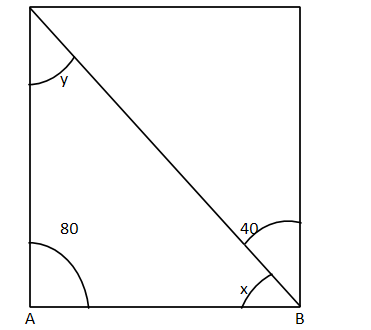
In the given figure $ABCD$ is a parallelogram. Find the angles $x{\text{ and }}y$


Answer
556.5k+ views
Hint: Here we are given one angle of the parallelogram. So we can find the consecutive angle by the property that any two consecutive sides of the parallelogram gas the sum of $180^\circ $ and also we know that sum of all the angles of the triangle is $180^\circ $
Complete step-by-step answer:
Here we are given that $ABCD$ is a parallelogram. Hence we came to know that $AB\parallel CD,BC\parallel DA$
Here we must know the properties of the parallelogram. Now let us see the figure.

Here we are given that
$
\angle ABD = x^\circ \\
\angle ADB = y^\circ \\
\angle DBC = 40^\circ \\
\angle DAB = 80^\circ \\
$
From the figure we get that the angles $\angle DAB{\text{ and }}\angle ABC$ are the consecutive angles.
Here we need to apply the property of the parallelogram that the sum of the any two consecutive sides if the parallelogram is $180^\circ $
So we can write that
$\angle DAB + \angle ABC = 180^\circ $$ - - - - (1)$
Now we also know that the $\angle ABC$ can be written as the sum of two angles which are $\angle ABD{\text{ and }}\angle DBC$
So we can write the equation (1) as
$\angle DAB + (\angle ABD + \angle DBC) = 180^\circ $
Substituting the value of the angles in the equation above, we get
$
80 + x + 40 = 180 \\
\Rightarrow x = 60^\circ \\
$
Also we know that all the angles of the triangle sum to $180^\circ $
Applying this property in $\Delta ABD$ and we will get that:
$\Rightarrow$ $\angle DAB + \angle ABD + \angle ADB = 180^\circ $$ - - - (2)$
We know that
$\angle DAB = 80^\circ $
Substituting the values in the above equation (2) we get:
$\Rightarrow$ $80^\circ + \angle ABD + \angle ADB = 180^\circ $
$\Rightarrow$ $\angle ABD + \angle ADB = 100^\circ - - - - - (3)$
Now we also know that
$
\angle ABD = x = 60^\circ \\
\Rightarrow \angle ADB = y^\circ \\
$
Substituting this value we will get the required value of the variable.
So we can write the equation (3) as:
$
60^\circ + y = 100^\circ \\
\Rightarrow y = 100 - 60 = 40^\circ \\
$
Hence we get that
$x = 60^\circ $
$y = 40^\circ $
Note: Here we can also do this by another method where we can say that $\angle ADB{\text{ and }}\angle DBC$ are the alternate angles of the two parallel sides which are equal hence we directly get $y = 40^\circ $
Now we can again find $x$ by the angle sum property of the triangle.
Complete step-by-step answer:
Here we are given that $ABCD$ is a parallelogram. Hence we came to know that $AB\parallel CD,BC\parallel DA$
Here we must know the properties of the parallelogram. Now let us see the figure.

Here we are given that
$
\angle ABD = x^\circ \\
\angle ADB = y^\circ \\
\angle DBC = 40^\circ \\
\angle DAB = 80^\circ \\
$
From the figure we get that the angles $\angle DAB{\text{ and }}\angle ABC$ are the consecutive angles.
Here we need to apply the property of the parallelogram that the sum of the any two consecutive sides if the parallelogram is $180^\circ $
So we can write that
$\angle DAB + \angle ABC = 180^\circ $$ - - - - (1)$
Now we also know that the $\angle ABC$ can be written as the sum of two angles which are $\angle ABD{\text{ and }}\angle DBC$
So we can write the equation (1) as
$\angle DAB + (\angle ABD + \angle DBC) = 180^\circ $
Substituting the value of the angles in the equation above, we get
$
80 + x + 40 = 180 \\
\Rightarrow x = 60^\circ \\
$
Also we know that all the angles of the triangle sum to $180^\circ $
Applying this property in $\Delta ABD$ and we will get that:
$\Rightarrow$ $\angle DAB + \angle ABD + \angle ADB = 180^\circ $$ - - - (2)$
We know that
$\angle DAB = 80^\circ $
Substituting the values in the above equation (2) we get:
$\Rightarrow$ $80^\circ + \angle ABD + \angle ADB = 180^\circ $
$\Rightarrow$ $\angle ABD + \angle ADB = 100^\circ - - - - - (3)$
Now we also know that
$
\angle ABD = x = 60^\circ \\
\Rightarrow \angle ADB = y^\circ \\
$
Substituting this value we will get the required value of the variable.
So we can write the equation (3) as:
$
60^\circ + y = 100^\circ \\
\Rightarrow y = 100 - 60 = 40^\circ \\
$
Hence we get that
$x = 60^\circ $
$y = 40^\circ $
Note: Here we can also do this by another method where we can say that $\angle ADB{\text{ and }}\angle DBC$ are the alternate angles of the two parallel sides which are equal hence we directly get $y = 40^\circ $
Now we can again find $x$ by the angle sum property of the triangle.
Recently Updated Pages
Master Class 9 Social Science: Engaging Questions & Answers for Success

Master Class 9 Science: Engaging Questions & Answers for Success

Master Class 9 English: Engaging Questions & Answers for Success

Master Class 9 Maths: Engaging Questions & Answers for Success

Master Class 9 General Knowledge: Engaging Questions & Answers for Success

Class 9 Question and Answer - Your Ultimate Solutions Guide

Trending doubts
Which places in India experience sunrise first and class 9 social science CBSE

Fill the blanks with the suitable prepositions 1 The class 9 english CBSE

Write the 6 fundamental rights of India and explain in detail

Difference Between Plant Cell and Animal Cell

What is pollution? How many types of pollution? Define it

What is the Full Form of ISI and RAW




